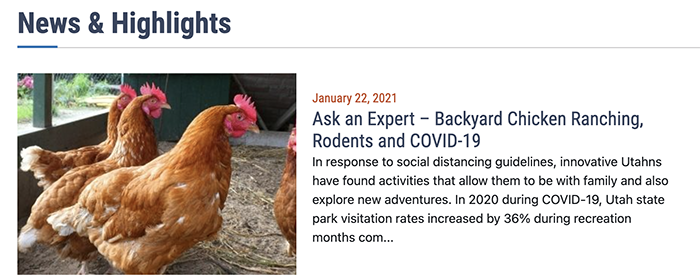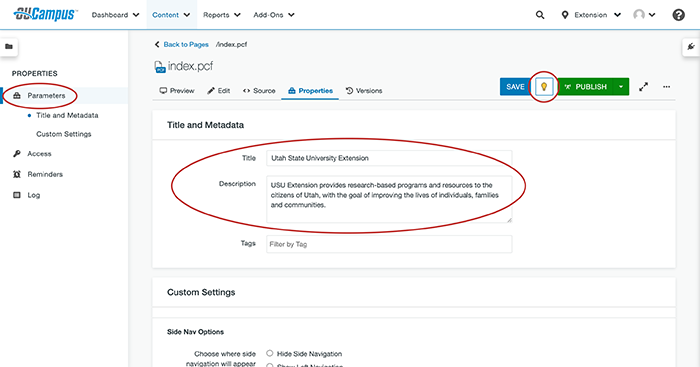How to Create Effective and Accessible Web Page Titles and Descriptions
Making sure web pages have good titles and descriptions are two ways to help your web pages be found in search results. It also helps users who use screen readers.
Every page on a USU website should have a meaningful title and description. This article will teach you how to create those elements in OU Campus. It will also teach you the best practices for writing them.
Why are Titles and Descriptions Important?
Search Engine Optimization
Search engines like Google pull titles and sometimes descriptions from web pages to produce search results. Writing them properly helps your page get found. Keeping descriptions and titles short stops also keeps them from being cut off in search results.

Accessibility
Good page titles are important for accessibility. They are the first thing visitors who use screen readers hear when they open a page. This quickly lets the user know if the page they’re on is relevant.
OU Campus News Feeds
OU Campus feeds (for things like news or research articles) pull titles and descriptions from articles. It’s important to remember this when writing article descriptions and titles.

In articles that will appear in OU Campus feeds, use the name of the article as the page's title and keep the description concise if you don’t want it to get cut off in the news feed.
Browser Bookmarks
By default, browsers use pages titles to name bookmarks. For this reason, it’s important that titles are descriptive, unique and include the name of the site.
Guidelines for Creating Good Page Titles
Indiana University recommends the following practices for writing page titles:
Page titles should be unique, concise and descriptive.
- They should be different from the other page titles on the same site and different from page titles on related sites.
- Titles should describe a page’s content and purpose.
- Titles should also include the name of the site after the unique page name (example: “About | Extension” rather than “Extension | About”).
USU web pages use the pipe character between the parts of a page title: “Page | Subsection | Section” (“ | Utah State University” is automatically added to the end of the title by OU Campus).
Page Title Examples
Bad: giving every page on a site the same title “Web Team”.
Not much better: giving a page a long title and putting the unique page name after the site name “USU Extension Web Team About Page”.
Good: giving each page a short, unique and descriptive name followed by the name of the subsection (“About | Web Team | Extension”). Remember OU Campus automatically adds “ | Utah State University” to the end of your page's title.
Important: When creating a news or research article page in OU Campus, just title the page with the name of the article (leave out the name of the site section and subsection). This is to cut down on redundancy.
Example: “Aggie Creamery Announces New Ice Cream Flavor” not “Aggie Creamery Annnounces New Ice Cream Flavor | Aggie Creamery”.
Guidelines for Creating Good Page Descriptions
Page descriptions are one way search engines obtain descriptions for their search results. Other times, artificial intelligence just pulls text from page content for result descriptions.
While it’s not possible to control what a search engine displays for your page’s result, Google recommends the following practices for creating page descriptions:
- Include a description on every page you create.
- Make descriptions unique to each page.
- Descriptions can be written in sentence format or include information like author, date or prices.
- Good descriptions help your page show up in search results. Stuffing descriptions with keywords doesn’t help, but crafting meaningful descriptions does.
Yoast, a company that makes SEO plugins, recommends the following additional guidelines: limit descriptions to 155 characters or less, write descriptions that will motivate users to take some action, use keywords but don’t keyword stuff and make sure the descriptions accurately describe your page’s content.
Page Description Examples
Bad: leaving the "Description" field blank.
A little better: stuffing description with keywords "Strawberry jam, berries, jam, fruit preserves, making jam, safe jam".
Good: giving page a descriptive title with active language "Learn how to make strawberry jam safely."
How to Add Descriptions and Titles to Pages in OU Campus
Follow these steps to give titles and descriptions to pages in OU Campus:
- Open a page in the OU Campus editor.
- Click on the properties tab at the top of the page.
- Make sure the page is “checked out.” If the lightbulb icon by the "publish" button isn’t yellow already, click it make it so.
- Click the “Parameters” tab on the “Properties” side menu.
- Enter the title and description in their respective boxes.
- Press "Save" and "Publish" when you’re done editing.


Sources
- Descriptive HTML page titles help users quickly understand a web page’s content (Indiana University)
- Create good titles and snippets in search results (Google Search Central)
- How to create the right meta description (Yoast SEO)

